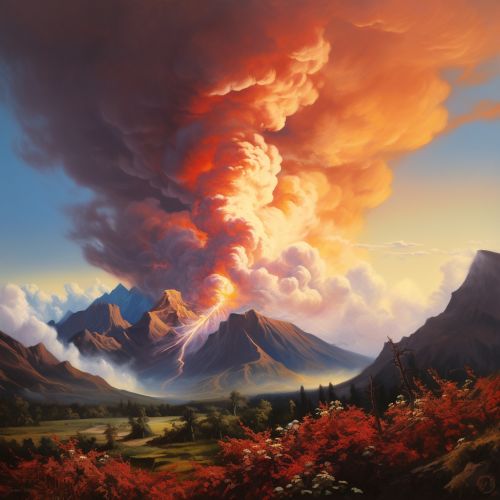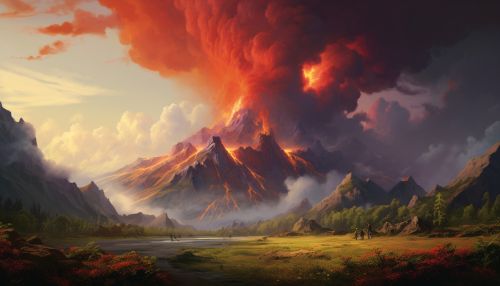Volcanic activity
Introduction
Volcanic activity refers to the eruption of molten rock, or lava, and gases from a volcano onto the Earth's surface. This process is driven by the movement of tectonic plates and the heat generated from the Earth's core. Volcanic activity is a key component of the Earth's geological and atmospheric processes, contributing to the formation of landforms, the release of gases into the atmosphere, and the regulation of the Earth's climate.
Types of Volcanic Activity
There are several types of volcanic activity, each characterized by different eruption styles, types of emitted materials, and resulting landforms.
Effusive Eruptions
Effusive eruptions occur when magma rises through the crust and lava flows out of the volcano's vent. The lava from these eruptions is typically low in viscosity, allowing it to flow easily across the landscape. This type of eruption results in the formation of shield volcanoes, such as those found in the Hawaiian Islands.
Explosive Eruptions
Explosive eruptions are characterized by the violent release of gas and pyroclastic material. These eruptions occur when the magma is high in viscosity and gas content, causing a build-up of pressure that eventually leads to a catastrophic explosion. The most common landforms produced by explosive eruptions are stratovolcanoes, like Mount St. Helens.
Phreatomagmatic Eruptions
Phreatomagmatic eruptions are a type of explosive eruption that occurs when water comes into contact with magma, causing a rapid expansion of steam that results in an explosion. These eruptions often occur in subaqueous environments or in areas with high groundwater levels.
Causes of Volcanic Activity
Volcanic activity is primarily caused by the movement of tectonic plates and the heat generated from the Earth's core.
Plate Tectonics
The Earth's crust is divided into several large and small tectonic plates that float on the semi-fluid asthenosphere below. These plates are constantly moving due to the heat generated by radioactive decay in the Earth's core. This movement can lead to the formation of volcanoes in several ways.
Subduction Zones
Subduction zones are areas where one tectonic plate is forced under another, leading to the formation of a deep ocean trench and a volcanic arc on the overriding plate. The subducted plate melts as it descends into the mantle, creating magma that rises to the surface to form volcanoes. This process is responsible for the formation of the Ring of Fire, a major area of seismic and volcanic activity.
Divergent Boundaries
At divergent boundaries, tectonic plates move apart from each other, creating a gap where magma rises to form new crust. This process leads to the formation of mid-ocean ridges and volcanic islands. The Mid-Atlantic Ridge is a prime example of a divergent boundary.
Hot Spots
Hot spots are areas of intense volcanic activity that occur independently of plate boundaries. They are thought to be caused by plumes of hot mantle material rising from deep within the Earth. The Hawaiian Islands are an example of a hot spot.
Magma Generation
The generation of magma is a key factor in volcanic activity. Magma is produced when the Earth's mantle melts, a process that can occur due to the increase in temperature, the decrease in pressure, or the addition of water. Once formed, the magma rises through the crust due to its lower density, eventually erupting at the surface as lava.
Effects of Volcanic Activity
Volcanic activity can have both positive and negative effects on the environment and human societies.
Environmental Effects
Volcanic eruptions can significantly alter the landscape and have a major impact on the environment. They can create new landforms, such as islands and mountains, and alter existing ones through the deposition of volcanic material. Eruptions can also release large amounts of gases into the atmosphere, which can affect the Earth's climate.
Climate Change
Volcanic eruptions can influence the Earth's climate in several ways. The release of large amounts of sulfur dioxide can lead to the formation of sulfate aerosols in the stratosphere, which can reflect sunlight and cause a cooling effect. On the other hand, the release of carbon dioxide, a greenhouse gas, can contribute to global warming.
Soil Fertility
Volcanic material, particularly ash, can enrich the soil with nutrients, making it more fertile. This can lead to increased agricultural productivity in areas surrounding volcanoes.
Societal Effects
Volcanic activity can have profound effects on human societies. While volcanic eruptions can cause destruction and loss of life, they can also provide benefits such as fertile soil and geothermal energy.
Hazards
Volcanic eruptions can pose significant hazards to human societies. These include pyroclastic flows, lahars, volcanic gases, ashfall, and tsunamis. These hazards can cause loss of life, destruction of infrastructure, and displacement of populations.
Resources
Volcanoes can provide valuable resources, such as minerals and geothermal energy. Volcanic areas are often rich in minerals due to the concentration of elements in magma. Geothermal energy, which is heat derived from the Earth's interior, can be harnessed for power generation in volcanic regions.
Monitoring and Predicting Volcanic Activity
Monitoring and predicting volcanic activity is crucial for mitigating the risks associated with eruptions. This is achieved through a combination of ground-based observations, remote sensing, and geophysical and geochemical measurements.
Ground-Based Observations
Ground-based observations involve the visual monitoring of a volcano for signs of unrest, such as changes in the shape of the volcano, increased seismic activity, and changes in gas emissions.
Remote Sensing
Remote sensing involves the use of satellites to monitor changes in a volcano's activity. This can include changes in the heat output of a volcano, changes in the shape of the volcano, and the detection of volcanic gases.
Geophysical and Geochemical Measurements
Geophysical measurements involve the use of instruments to detect changes in the Earth's magnetic field, gravity, and seismic activity. Geochemical measurements involve the analysis of gases and fluids emitted by a volcano to detect changes in composition that may indicate an impending eruption.
See Also
- Plate Tectonics
- Lava
- Effusive eruptions
- Explosive eruptions
- Phreatomagmatic eruptions
- Subduction zones
- Divergent boundaries
- Hot spots
- Remote sensing


